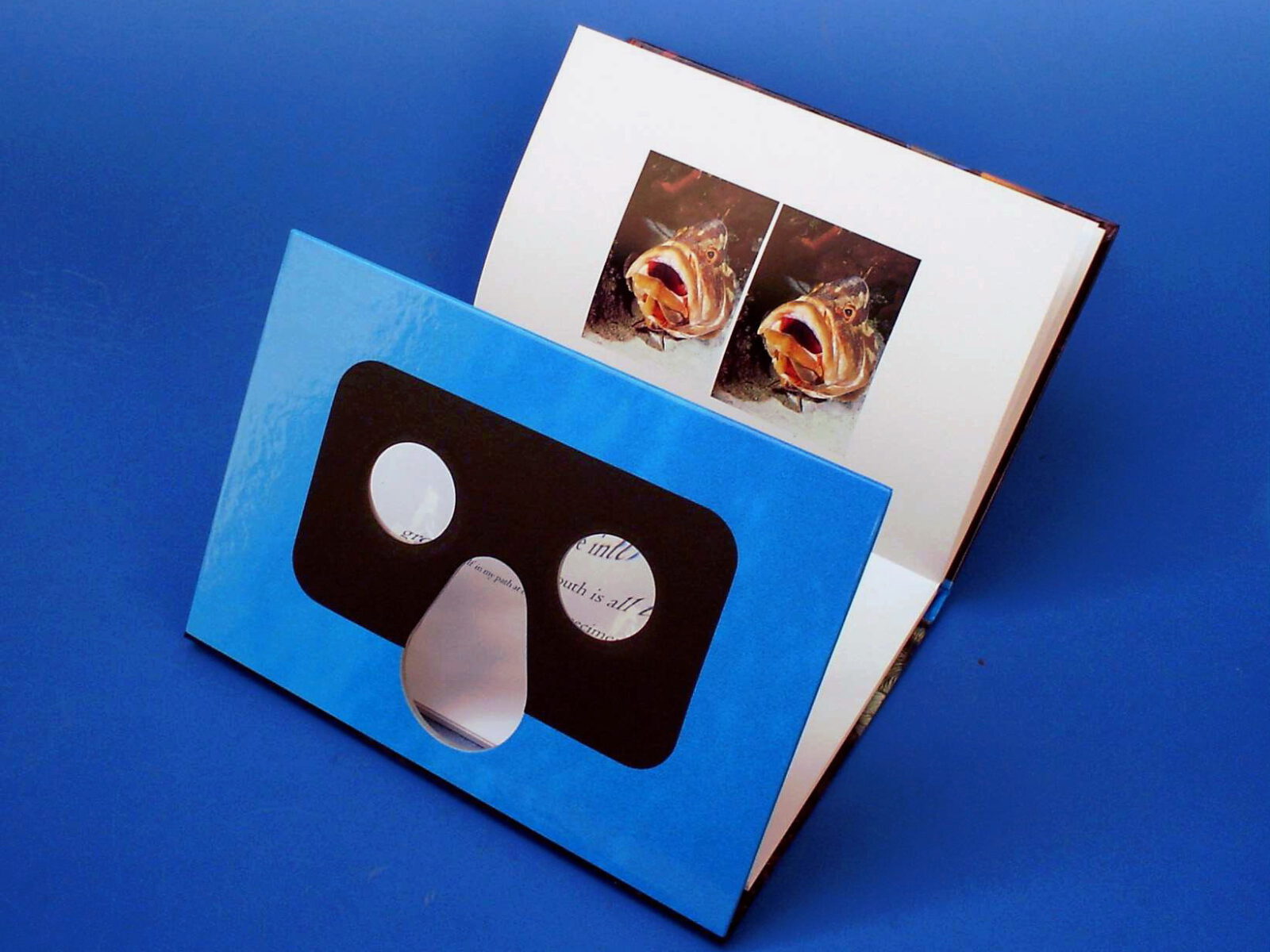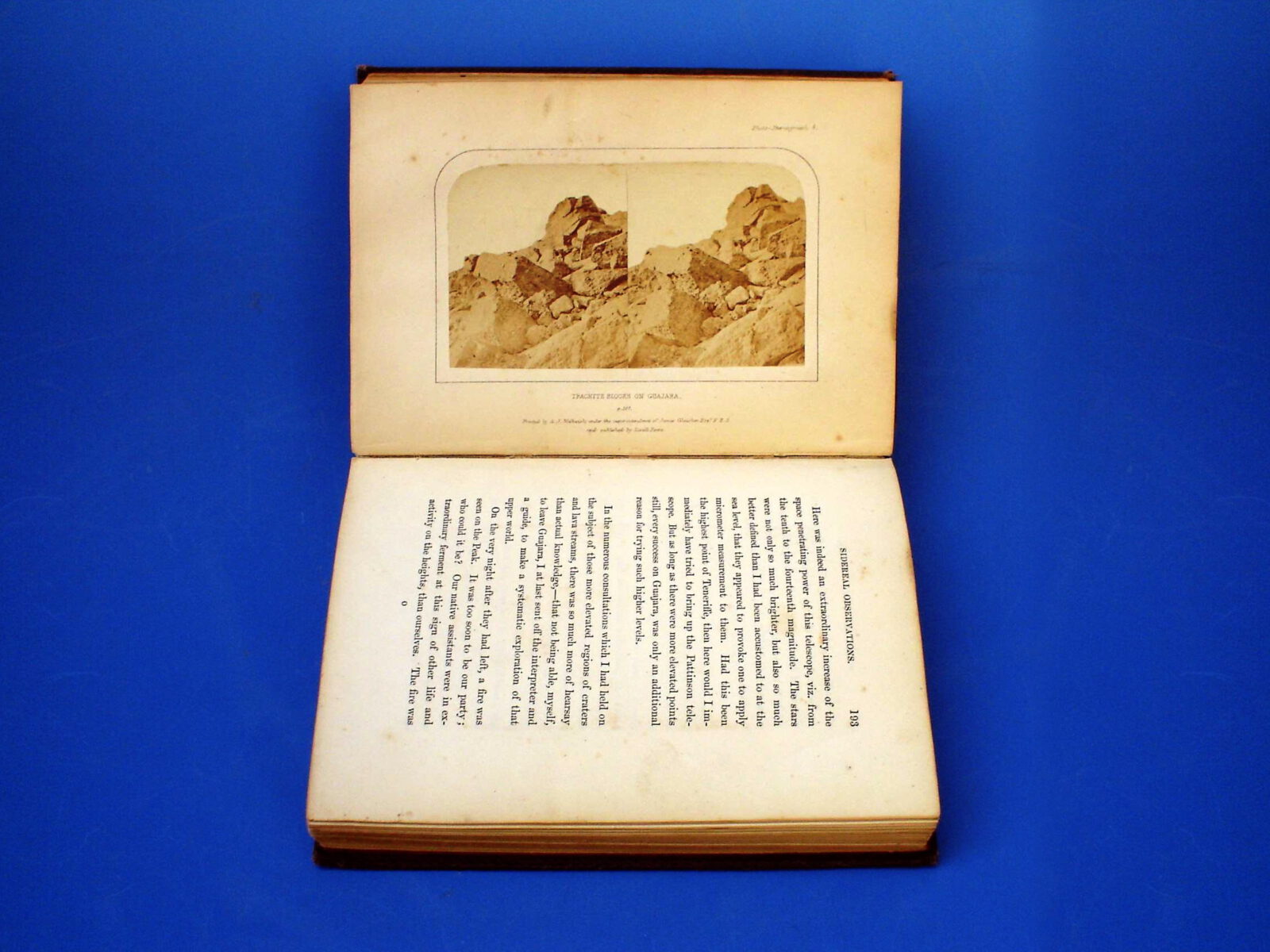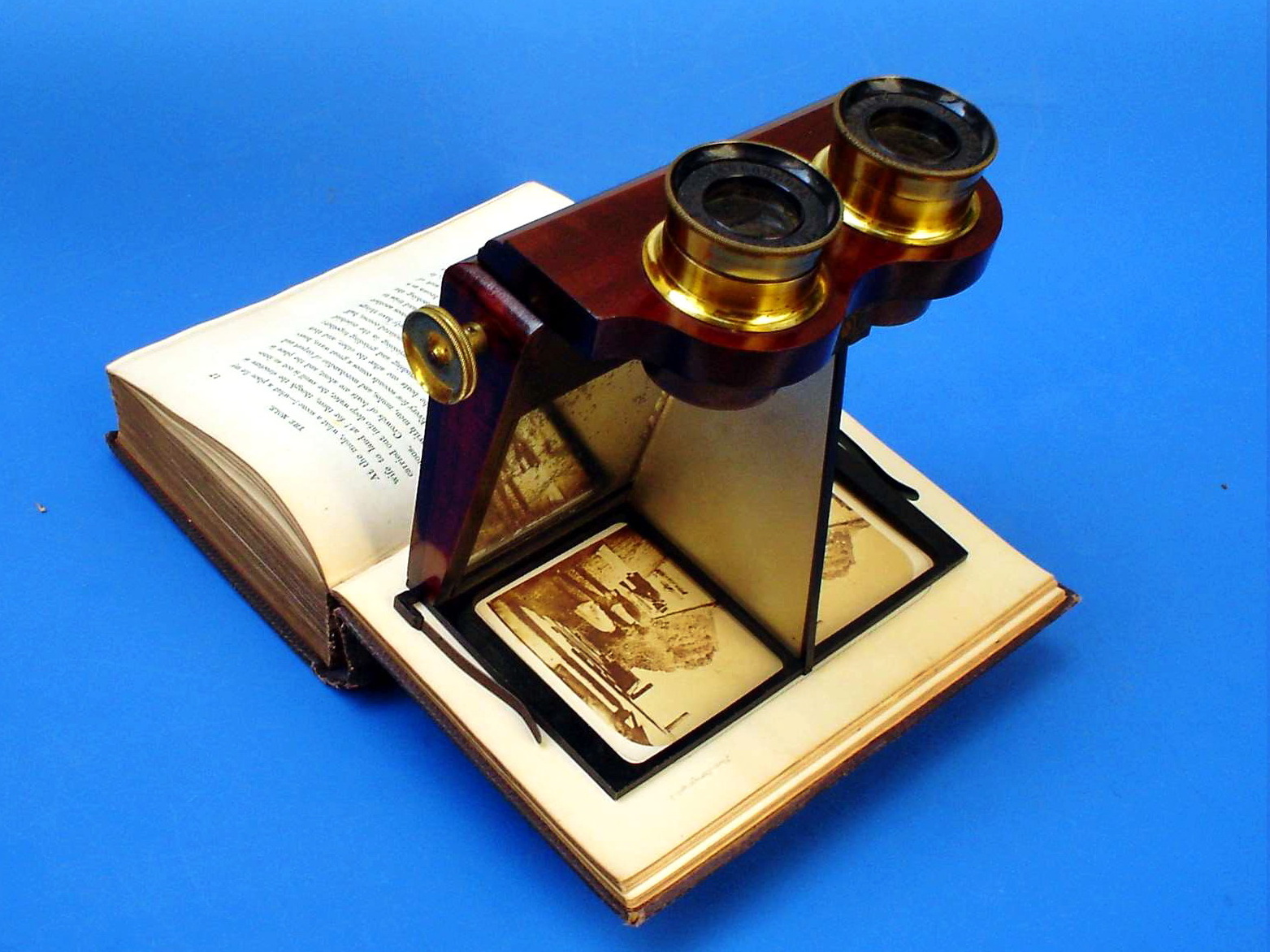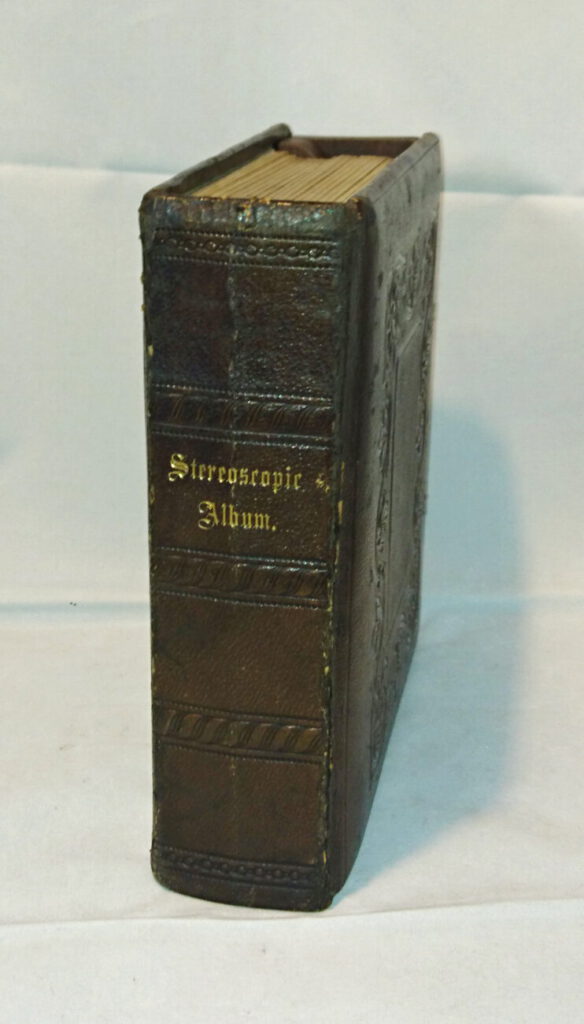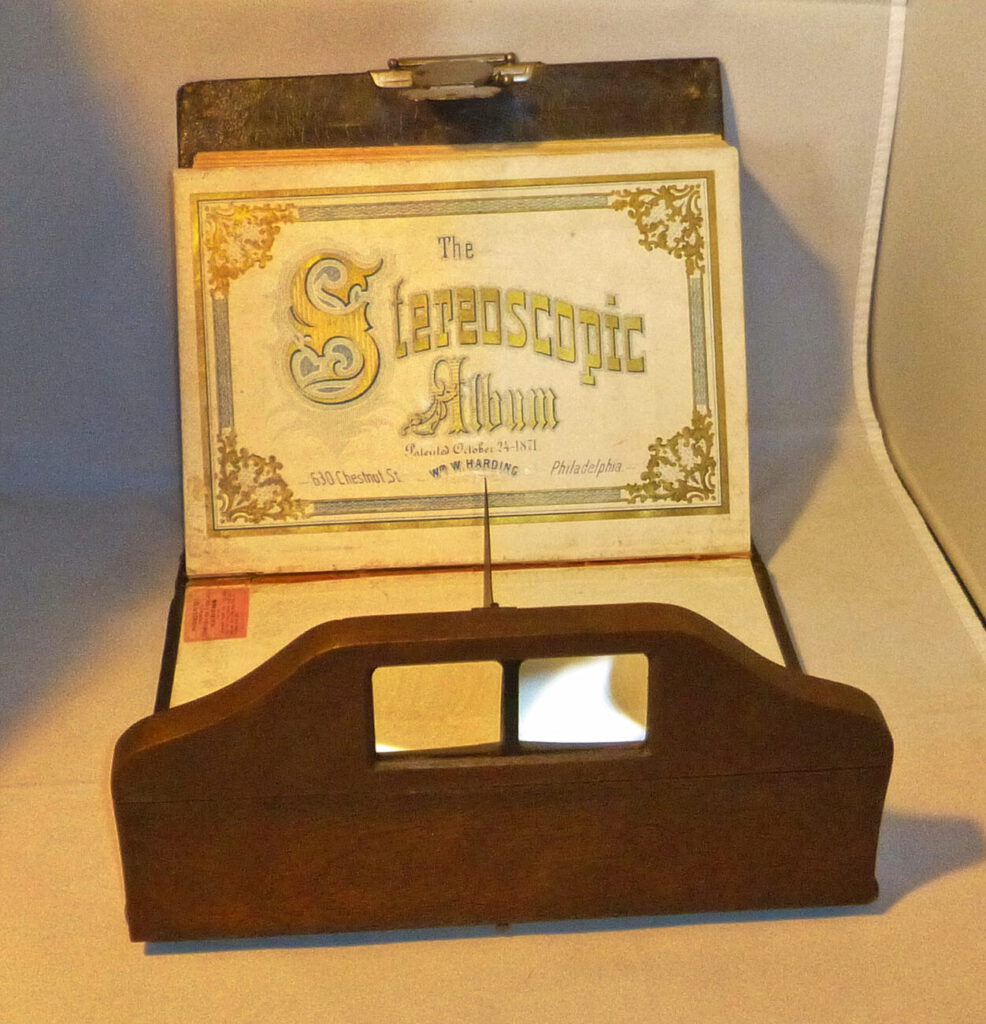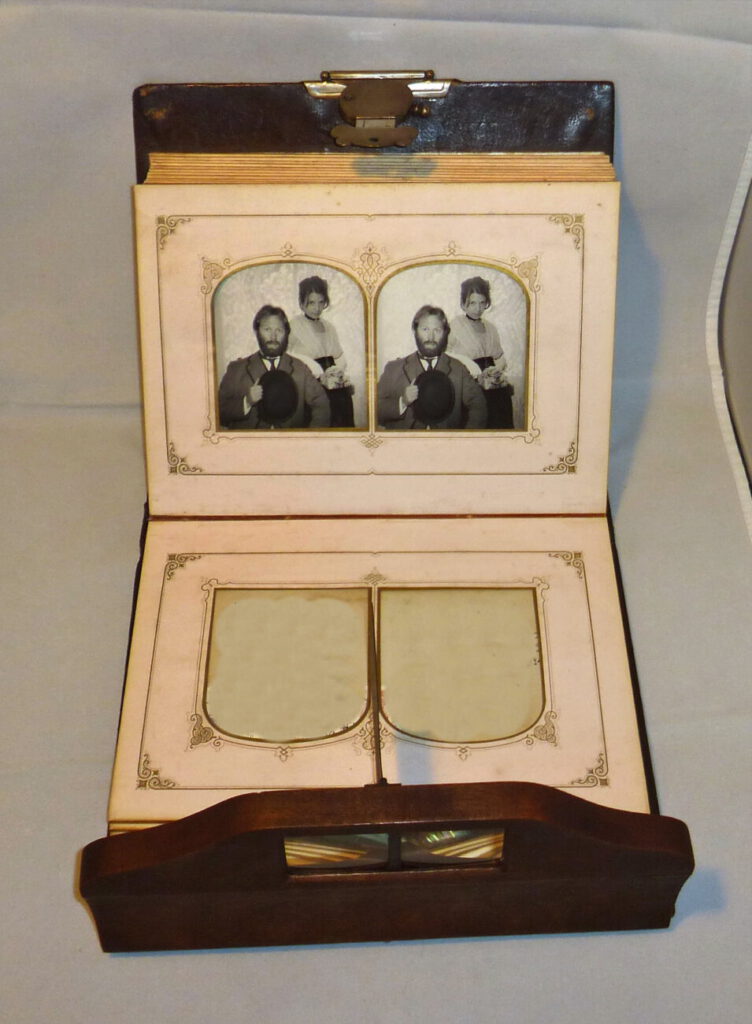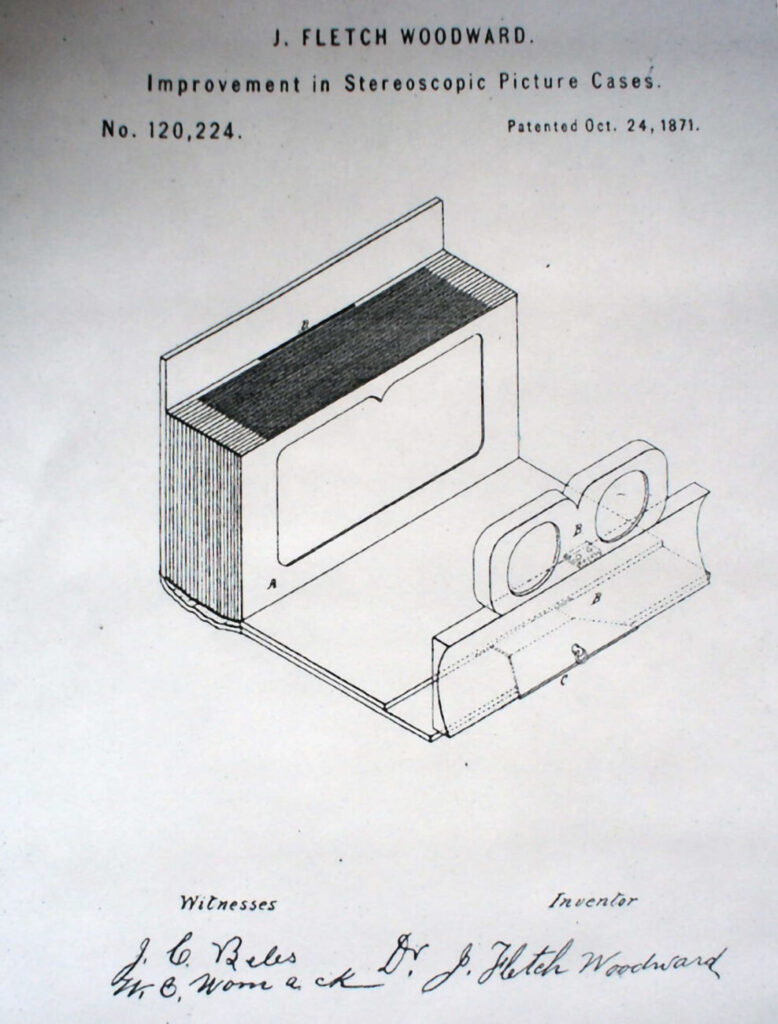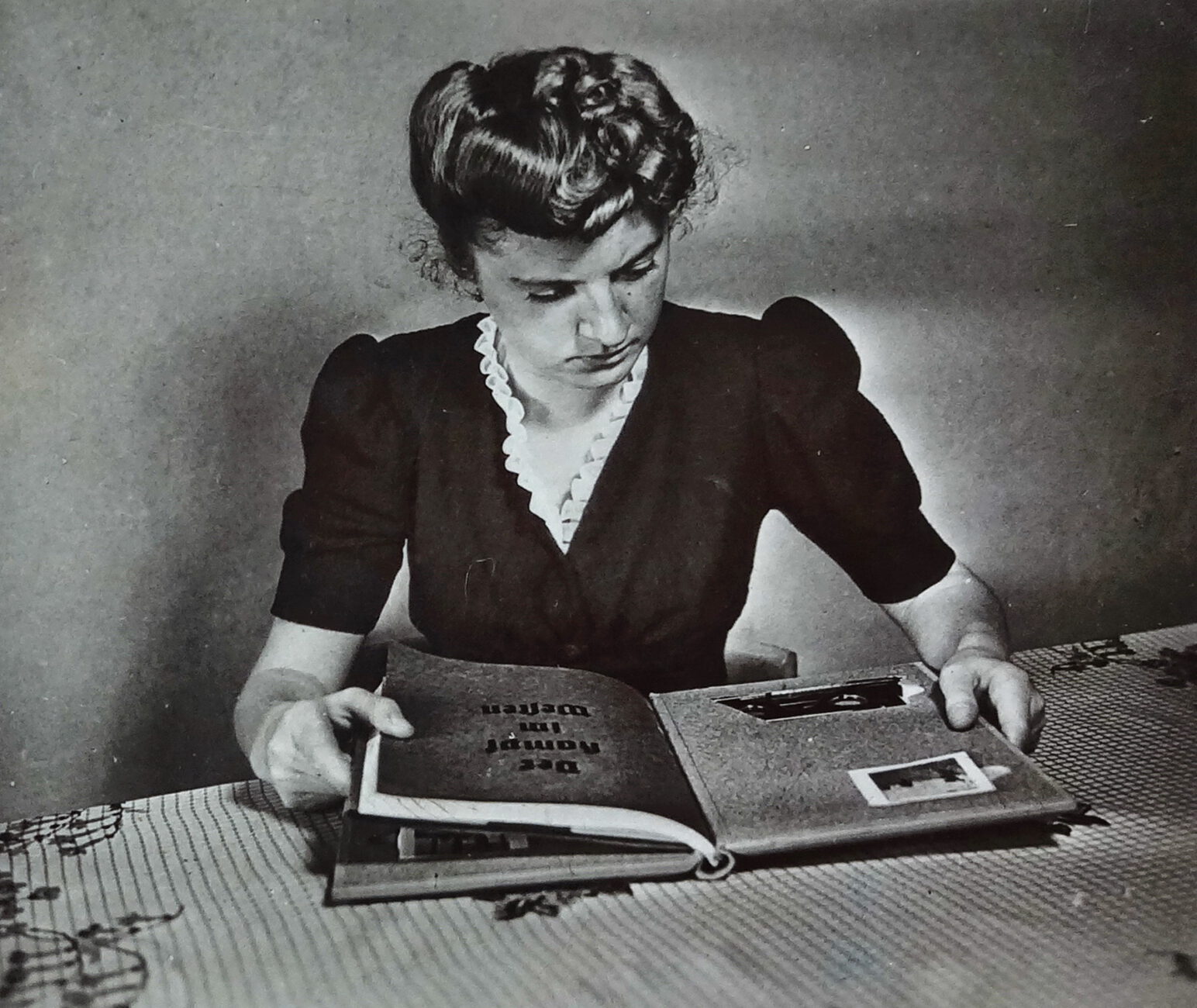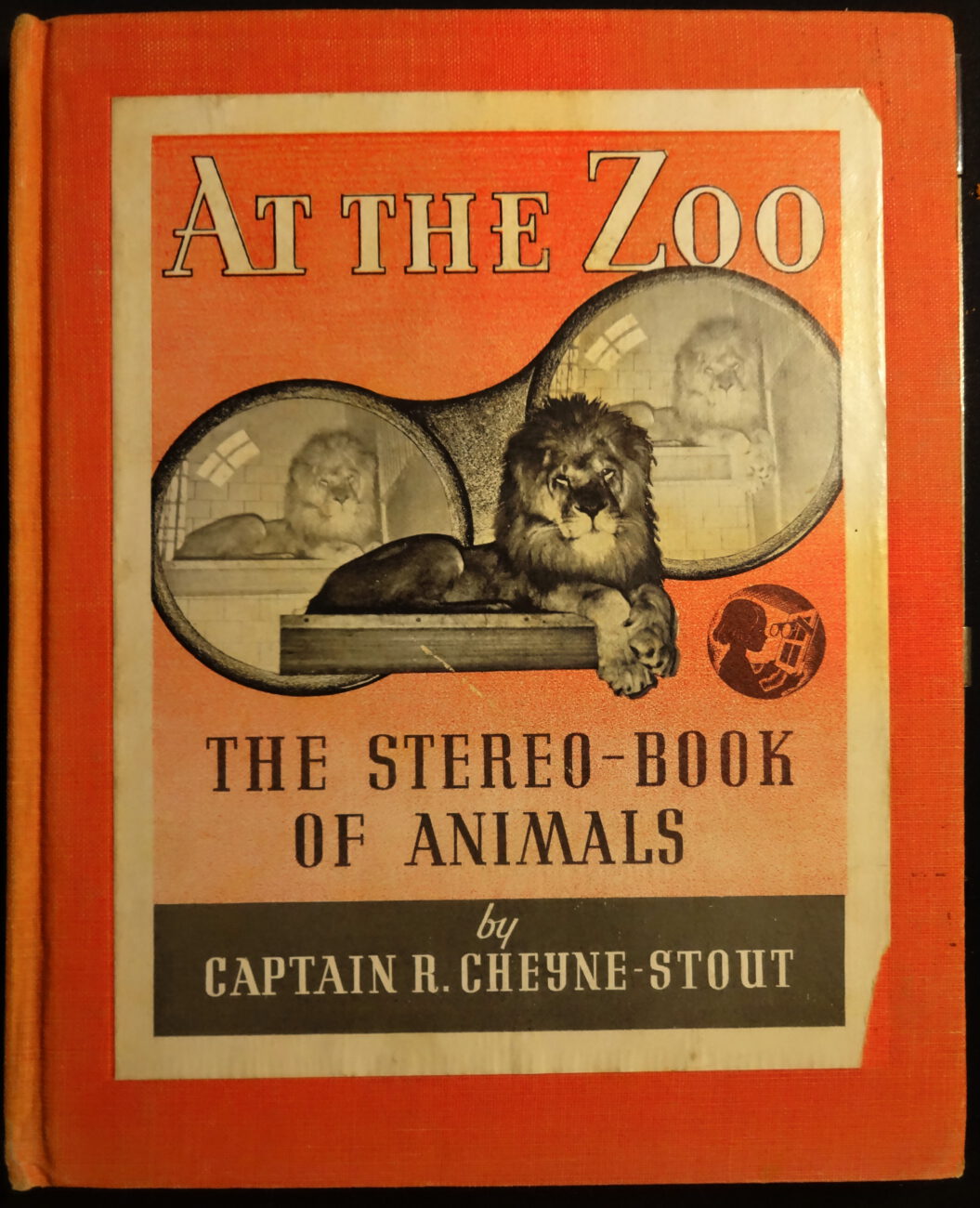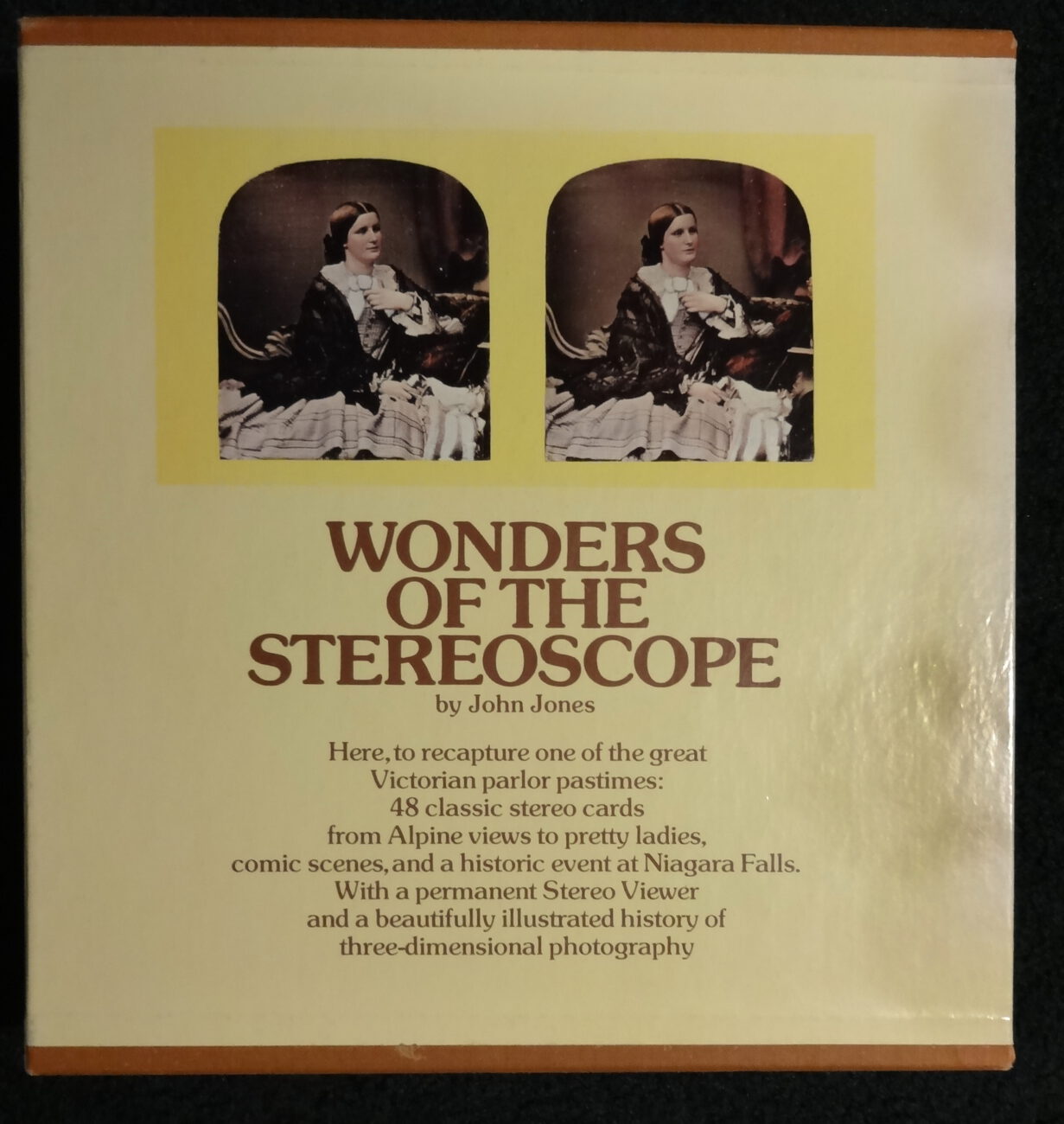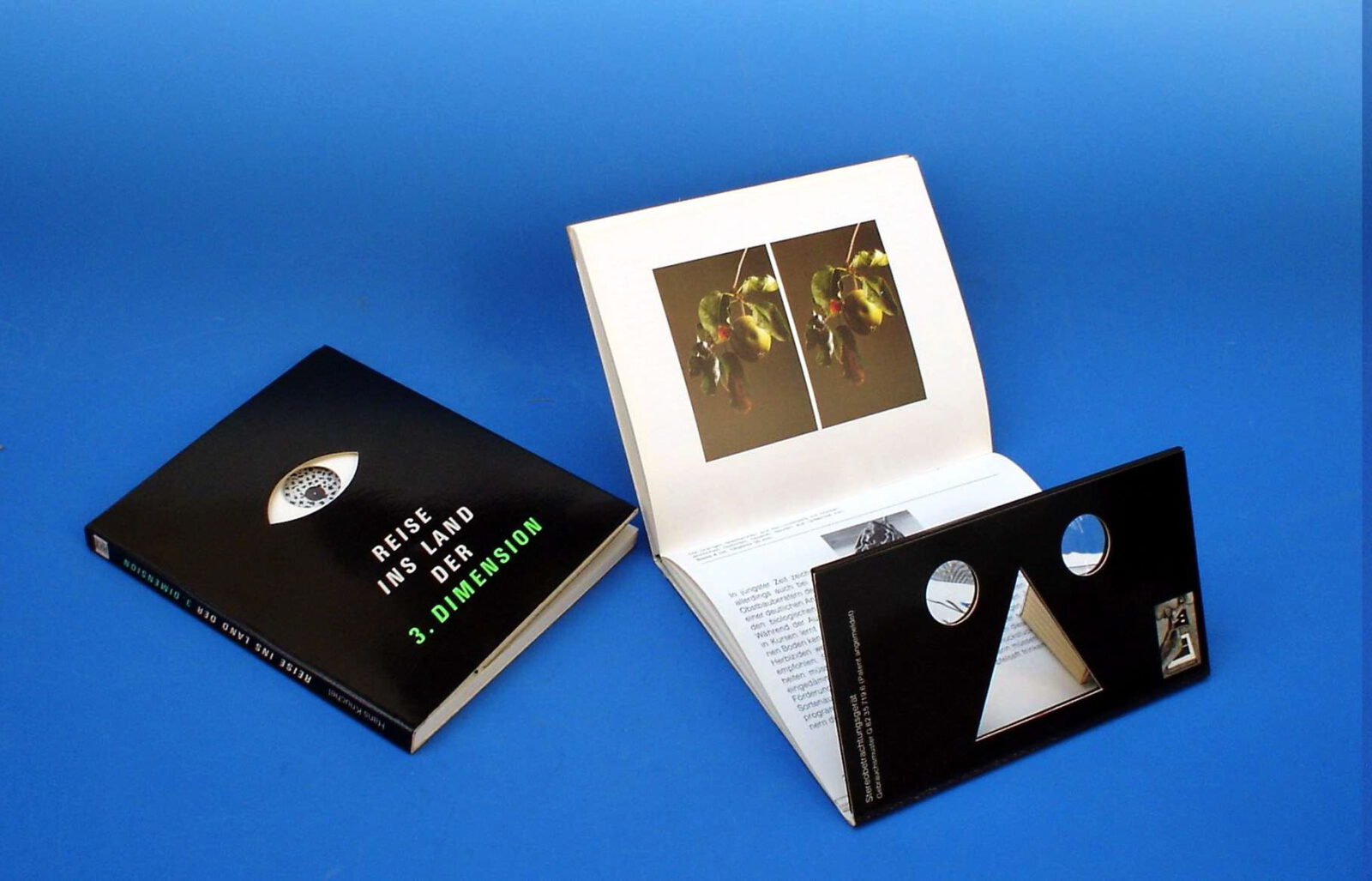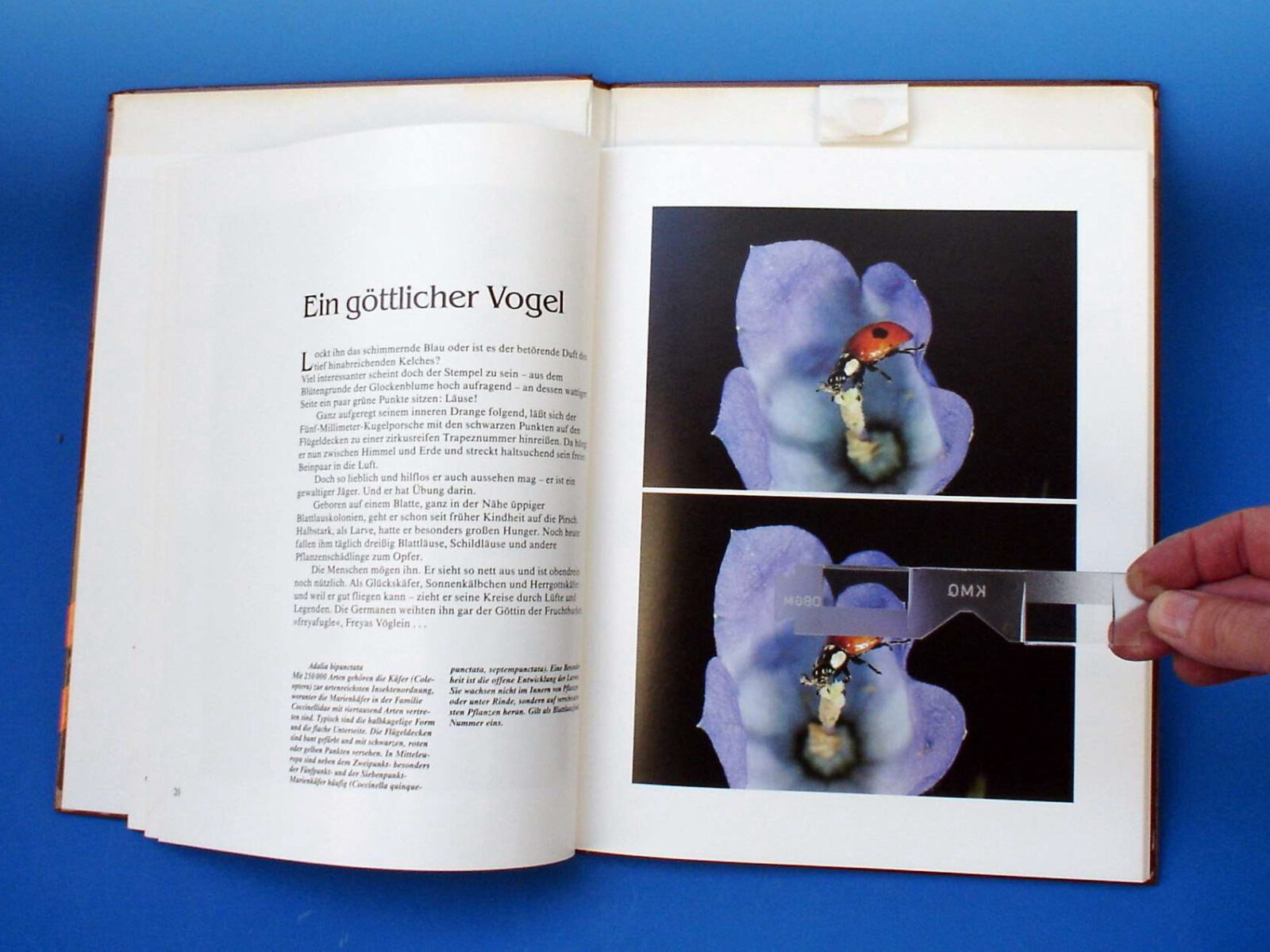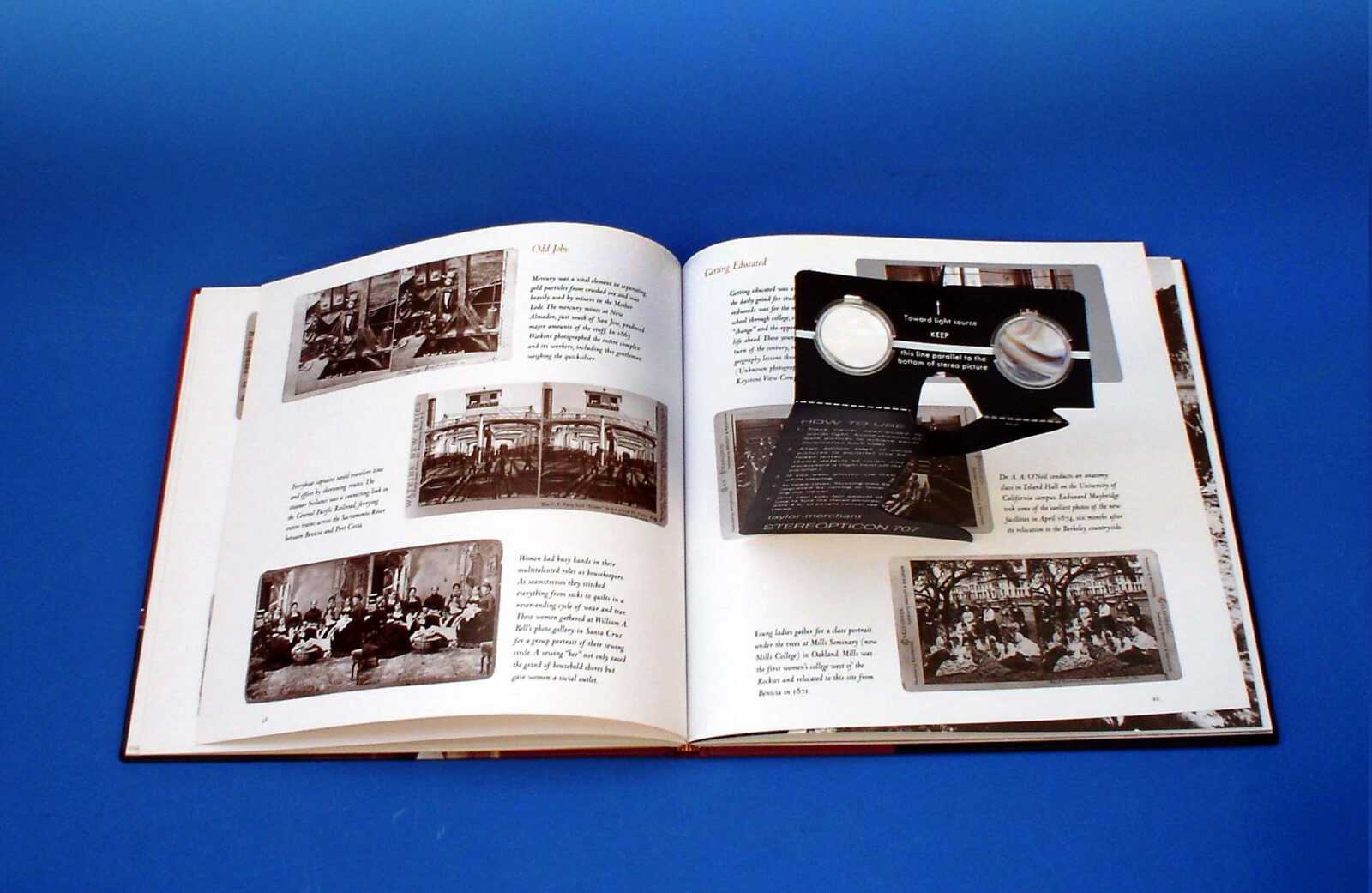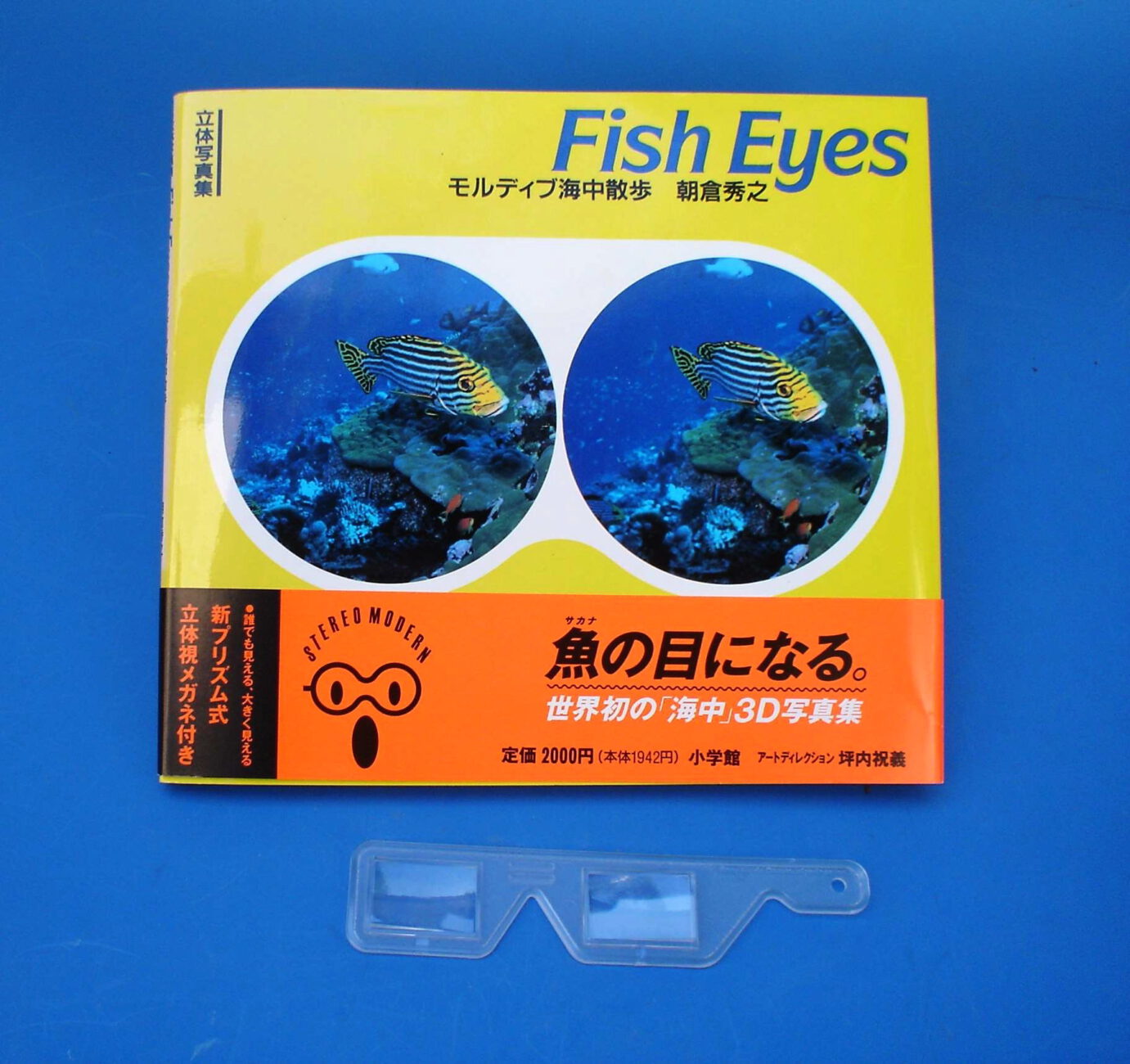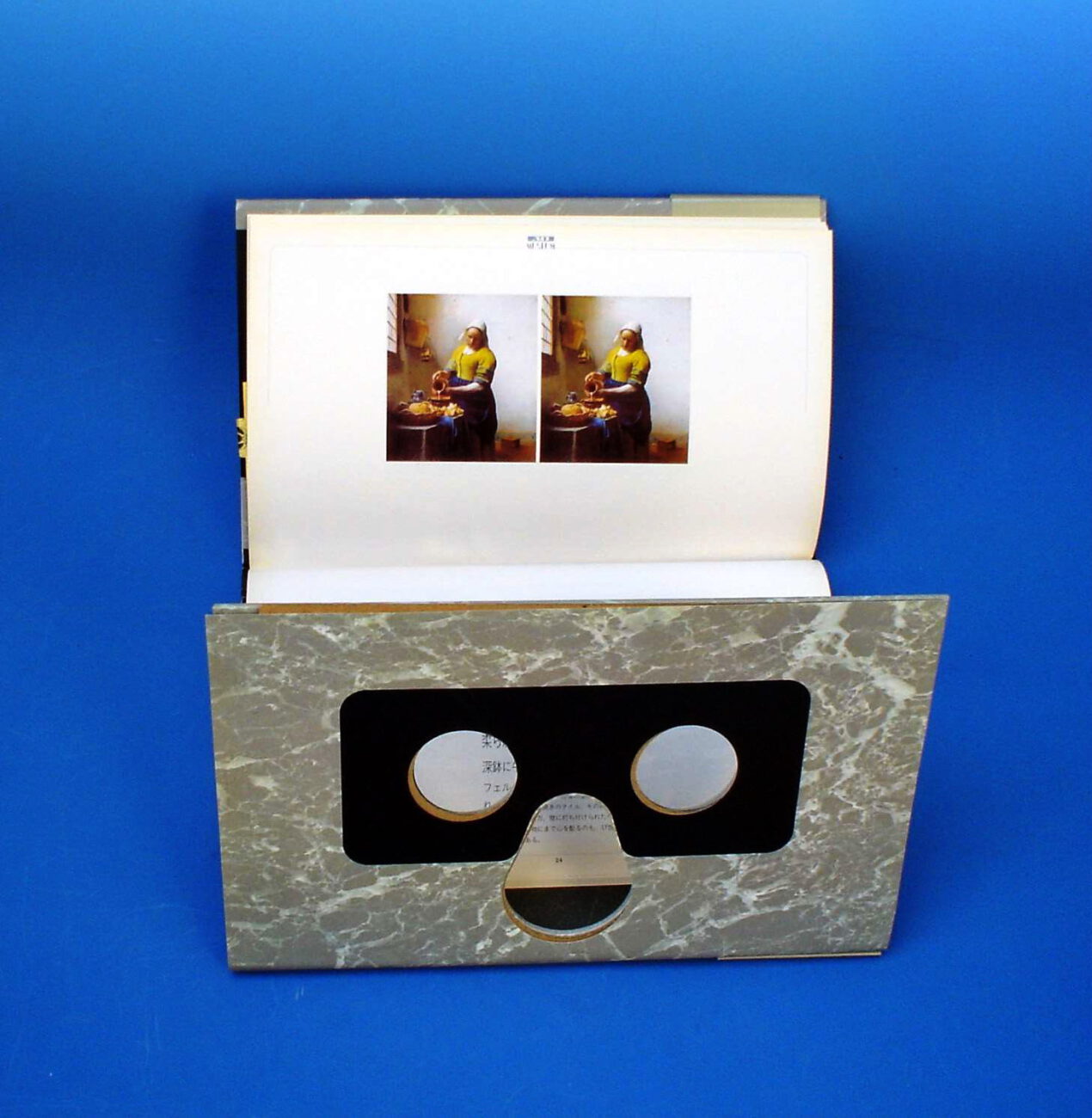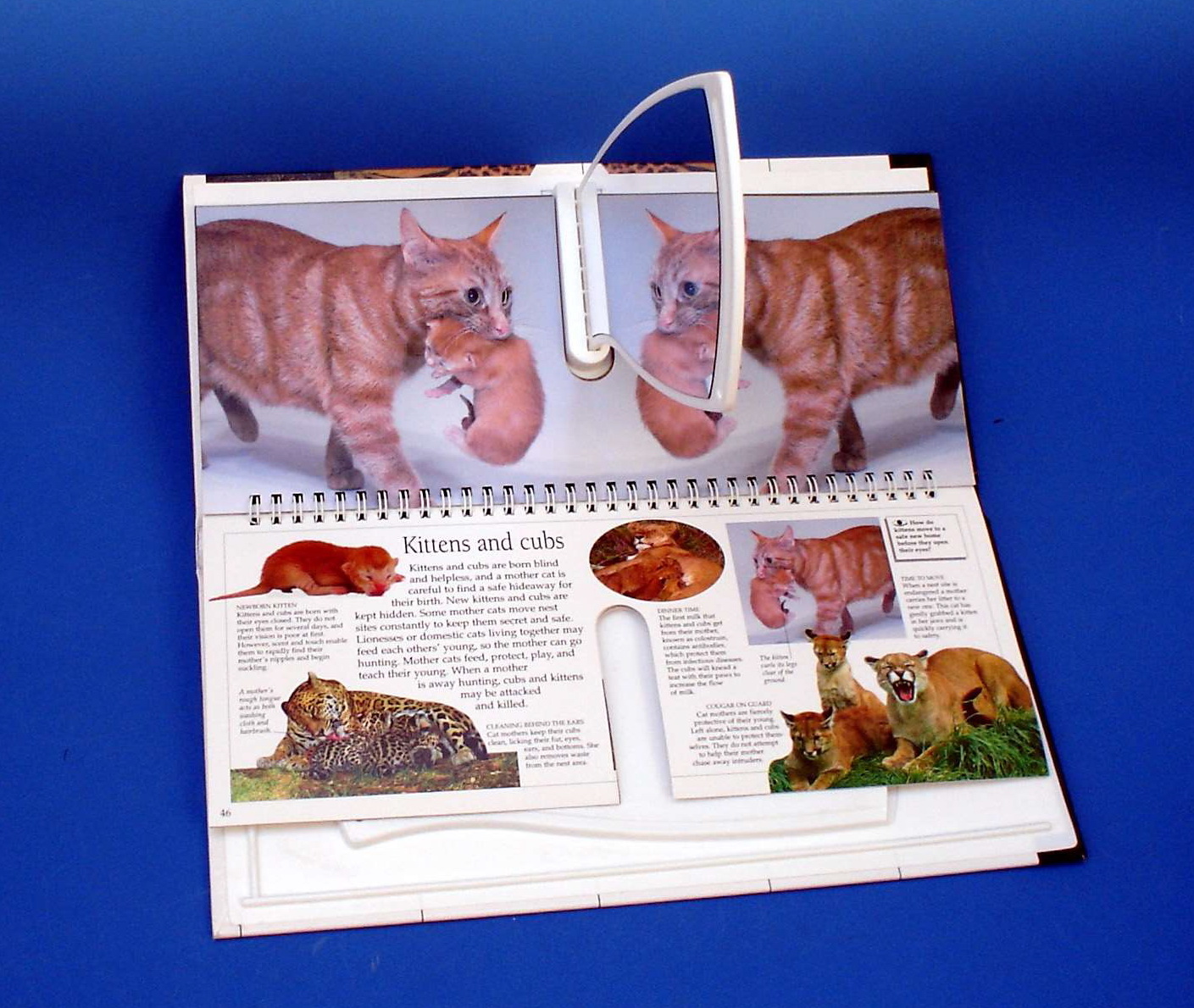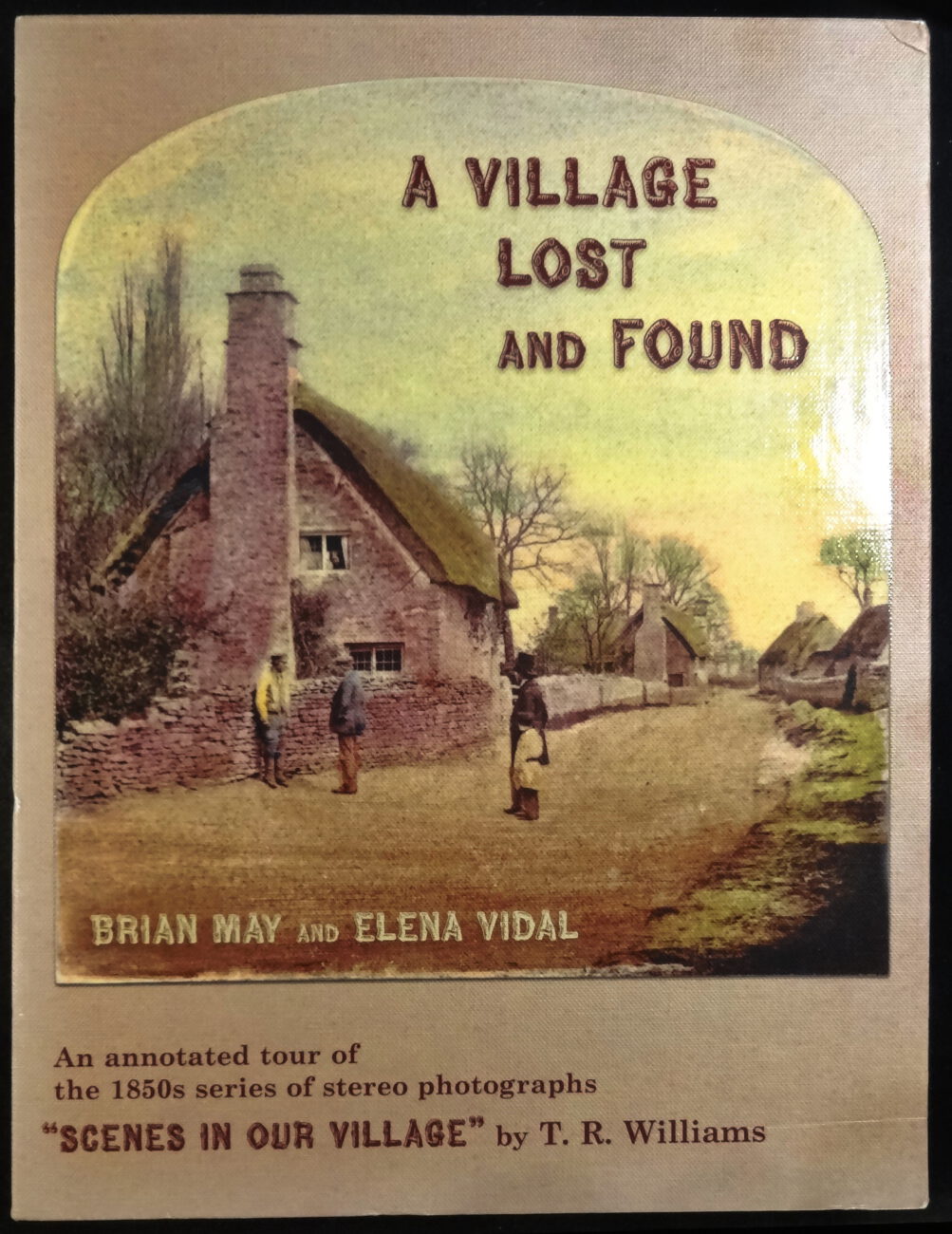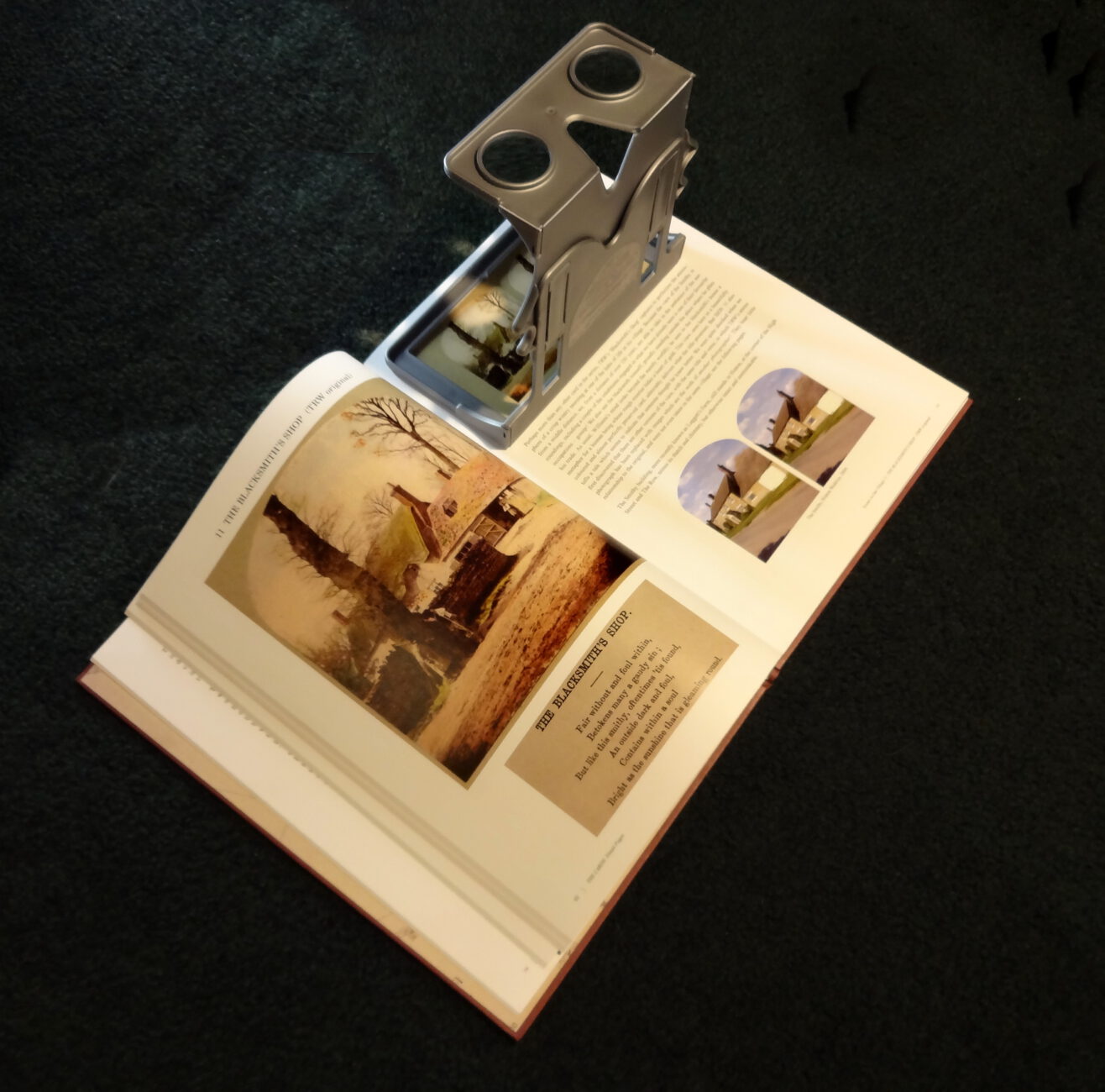An Abbreviated History of Stereo-Pair Illustrated books
written by David Starkman, USA
Introduction
The first book that I ever saw illustrated with stereo pairs was “The Stereo Realist Manual” by Morgan & Lester, published in 1954. This book featured side-by-side stereo pairs that were approximately 2.25″ x 2.25″ square, both in color and black-and-white. For viewing, a plastic hand-held stereo viewer was included in a pocket glued inside the back cover of the book. It was simple, and quite effective. This same viewer is still being made today, and has been included with numerous books. The most recent wave of 3‑D books with stereo pairs have been a series published by Chronicle Books (beginning with “Beneath the Sea in 3‑D”, and followed by many others in the same format). These have the images printed sideways (parallel to the spine of the book) with fold out flap in the back cover which incorporates the viewing lenses. This basic concept and format turns out to be quite old, but more about that later.
Somewhere along the way I became fascinated with the idea of stereo illustrated books that incorporate a viewer, and how to achieve this with stereo pairs, rather than anaglyphs.
19th century
The first book ever to incorporate actual side-by-side stereo pairs was “Tenerife, An Astronomers Experiment” by C. Piazzi Smyth, published in 1858 by Lowell Reeve in London. Accompanying the text were 20 albumen stereo images, which were logically included by having an outline for the stereo pair, and the caption printed on a page, and then the separate right and left images pasted onto the pages. Obviously a labor intensive process, the book was issued in an edition of 2,000. The publisher offered an accessory “Book Stereoscope” manufactured by Negretti and Zambra.
The idea of such stereo illustrated books must have had some popularity, as the well known stereoscope maker Smith, Beck & Beck made a special book stereoscope and patented it in 1859. The viewer is designed to rest directly upon the stereo pair. The lens panel moves up and down by means of an adjustment knob to allow for focusing. The achromatic lenses are prismatic, and may be rotated to adjust for images of various sizes. An angled mirror on the vertical supporting panel reflects light onto the images, and the septum is made of frosted glass, to reduce shadows that it might cause on either of the images. Even today one could not think of a single feature to improve on the design of a stereoscope for this purpose! To the best of my knowledge a better, or even equal, viewer for book stereo pairs has never been made.
The next, and much more ambitious use of stereograms in a book was “Egypt, Nubia, and Ethiopia” by Joseph Bonomi, with notes by Samuel Sharpe, published in London in 1862. This attractive book contains 100 stereoscopic photographs, consisting of actual photographic prints pasted side-by-side onto a horizontally oriented page. There is no border for the prints, just a caption centered below them.
This is all just a background for what really intrigues me more — stereo illustrated books that actually incorporate a viewer into the design. The first such mention of a book incorporating a stereoscope was pointed out to me by Paul Wing. It is a Mascher design — the same Mascher who had introduced the stereo daguerreotype viewing case. The Stereoscopic Book was introduced in an 1856 issue of Scientific American. A flat lens panel was attached to the cover of the book, and the stereo photos placed on the pages that face the lens panel. While one would expect to find more, the only known example of a Mascher Stereoscopic book is in the Smithsonian collection. In 1871 J. Fletch Woodward patented a stereo photo album design that looks like a book, and the design could easily have been incorporated into a book — albeit a very expensive book.
Perhaps the first most significant incorporation of a viewer into a book was in the book “Gems of American Scenery — White Mountains.“ This was printed in 1878 using an 1876 patent by Edward Bierstadt, and consisted of a thin folding flap on the cover of the book, with 1/2” square prismatic lenses. The 24 views were printed on heavy stock in the Artotype Process, and are remarkable today for their photographic quality, yet with the non-fading advantages of the printing process. The Chronicle books mentioned at the beginning of this article are basically an updated version of this 1876 design!
Schoenstein, Germany
The next book design to intrigue me was the “Raumbild Album” introduced by Otto Schoenstein in Germany around 1935. Although the viewer is not permanently attached to the book, neither are the views. The book consists of very thick covers large enough for A4 size text pages. The covers contain pockets; one for a folding stereoscope, and several more for separate stereo view cards printed on thick photographic paper. In the most common configuration there are four card pockets, each with 25 views, and text pages bound into the middle of the book. In some Raumbild books, such as the 1936 Olympic Games, the first 25 views are pasted onto thicker pages that are incorporated into the text pages.
The Raumbild book is one of my favorite designs. It has the outward appearance of a book, and can contain text pages like a book, but it functions more like a boxed set of stereocards with an accompanying textbook. Although Schoenstein experimented with some other designs over the years, this was the principal one. The design was used for a number of Nazi propaganda titles through the World War II years, and was last used in 1952 for a book on the Helsinki Olympic games.
Farrar & Rinehart, USA
In 1937, three quite remarkable books were produced in the USA by Farrar & Rinehart, Inc. of New York. These were “Sailing In: The Stereo Book of Ships”, “At The Zoo: The Stereo Book of Animals”, and “What is it? The Stereo Book of Puzzling Pictures.” The books incorporated a folding stereoscope design by Mr. Van Dyke Hill.
On the back cover of the book metal clamps attached to it hold a square rod which has a small rounded section at the bottom end. A recess at the bottom edge of the cover holds a small metal framed flat stereoscope, which is connected to the square rod by a flat telescoping arm with a square tube at the end, which surrounds the rod. When the square tube on the arm is at the lower end of the rod, which has the round section it may be folded into the recess in the book cover along with the stereoscope. To use the stereoscope one folds the arm vertical in relation to the book, and then slides it upwards so that the square part of the tube engages the square rod. Once the tube is seated on the square part of the rod the arm will stay vertical on it’s own. Then the lens panel is flipped over into the viewing position, and the arm may be extended to focus properly on the stereo pairs that are printed on the parts of the page that will align with the stereoscope. Three images may be placed on each page, and the lens panel may be slid up or down on the rod to bring it into viewing position for each of the three stereo images.
Wonders of the Stereoscope, USA
In the late 1970s a book appeared on the popular market which was quite ambitious, and received national distribution in the USA at popular bookstores (I know, because we bought our copy new!). “Wonders of the Stereoscope” featured a hard cover textbook, and a second “book” fitted into the same hard slip case which contained a recessed area for a set of lithe stereo view cards (reproductions of antique originals) and a unique folding plastic stereoscope. The stereoscope was unique and designed specifically for this book. I don’t know how many were produced, but examples today are fairly scarce, and the design does not seem to have been used again.
Tanner+Staehelin, Switzerland
In 1983 the Swiss publisher Tanner+Staehelin came out with two books that incorporated a stereo viewer into a folding flap on the back cover. By printing the stereo views only on the pages facing the viewer, and the text on the remaining pages, they came up with a very modern and efficient design for a stereo-pair illustrated book, with built-in viewer. The basic design is really just an updateon the original Mascher concept, and the design used in the “Gems of American Scenery — White Mountains” book. The two books were titled “Reise Ins Land der 3.Dimension” (Journey into the Land of 3‑Dimension) and “Baumbuch” (The Tree Book). The first book was in Black and white, and the second one in color. Both books incorporated a unique dotless screen printing process that offered near photographic quality. The first book used a lens panel folded over from the cardboard back cover, with the lenses glued into the sandwich formed by the flap.
KMQ, Germany
There is another variation on this theme that is also worth mentioning: Over/Under illustrated books. In this format the right and left images are place one above the other, and a prismatic viewer with prisms angling upward and downward to bring the two images together is used. The main advantage of this format is that there is no size limit to the printed pictures, and even panoramic views may be presented. This concept is mentioned in the 1903 “Stereoscopic Phenomena of Light and Sight” by Theodore Brown (reprinted in 1994 by Reel 3‑D Enterprises, and now out-of-print), but not commercially exploited in a book until the KMQ company in Germany came out with a low-cost plastic over/under prism lorgnette. As far as I know they have only used it in one book (Faszinierende Natur, 1983).
Chronicle Books, USA
Going back to the more traditional side-by side concept, this idea has most recently been used for a series of 3‑D books published by Chronicle Books in San Francisco, California. Their first venture into this was with the book “California in Depth” by Jim Crain published in 1994. This book used a page size of 10” wide by 9.5” high.
Throughout the book complete stereo cards were reproduced in a sepia tone to an overall width of 5”, rather than the original 7”. This had the effect of reducing the center-to-center distance to 2.25” for better viewing with the enclosed folding stereo viewer, contained in a pocket in the back of the book. In 1997 Chronicle Books published a further series of 3‑D books by Mark Blum, starting with “Beneath the Sea in 3D”. These books were all in the same book format as “3D Museum” from 1995, using a viewer incorporated into the back cover, remaining a permanent part of the book.
Shokokugan, Japan
In 1995 & 1996 Shokokugan has produced several stereo books with side-by-side stereo pairs. The first was called “Fish Eyes”, and features stunning full color underwater 3‑D photography taken with a custom underwater stereo camera rig. For this book a new all plastic lorgnette style viewer was produced, and put in an envelope in the back of the book, in a very similar fashion to the 1954 “Stereo Realist Manual”.
The next book, “3‑D Museum” consists of famous works of art (Such as the Mona Lisa, works by Dutch Masters, French Impressionists, etc.) converted by computer manipulation into full three dimensional images. This book proves that with modern skill and technology you CAN make a 3‑D picture out of a 2‑D one. The images are just stunning, and the 3‑D conversion is virtually flawless. For this book Shogokugan copied previous designs, with yet another variation on the “lens panel flap in the back of the book” concept. The only major difference is the use of very large diameter lenses, making the viewing even easier.
DK Publishing, UK
In 1998 DK Publishing, based in the UK, began a series of teen oriented 3‑D books in a series called “Eyewitness 3D”. These books all used a method of presenting 3‑D where the Left Eye image is printed reversed (mirror image), while the Right Eye Image is printed normally. Through the use of clever design, injection molding of plastic, and die cutting the pages, the book incorporates a mirror as the viewing aid to see the stereo pair. The uniquely shaped plastic framed mirror stores flat in a pocket in the back of the book, and inserts into a slot between the right and left images for viewing. The design allows for the pages of the book to be turned, while the mirror remains in place. At least 8 titles were made in this series: 3D Cats, 3D Human Body, 3D Rocks & Minerals, 3D Insect, 3D Microlife, 3D Ocean Life, 3D Plant, & 3D Reptile.
The idea to print this way is not new. Several 1950’s magazines used this method, with the idea that a viewer need not be supplied, as a simple pocket mirror could be used. DK, however, has to be given credit for coming up with a design viable in a published book format. As the author I have to express my personal opinion that while this format works well (once you figure out the best viewing and lighting positions), the book size is inconvenient and awkward. Each book is 13 inches tall and 6 inches wide, making it very unfriendly for storing on a bookshelf!
London Stereoscopic Company, UK
Most significant of the recent publications is a series of books published by Brian May and the London Stereoscopic Company. This began in 2009 with the publication of “A Village Lost and Found”. To create a publication of the highest quality, he and his company came up with a book design consisting of a hard cover book containing the stereo pairs, a rigid slip-case to hold the book, and also a folder containing a custom designed book stereoscope. Called the “Owl” viewer, it folds flat to fit into the slip case that sits adjacent to the book. When opened up, and folding part snapped into the final viewing positions, it is a true hand held stereoscope design that can be rested on top of the stereo pairs in the book for viewing. It even incorporates a focusing feature. A final bonus is that classic 3.5″ x 7″ stereo view cards may also fit into the holder on the viewer for stereo viewing. Since 2009 seven more books have been published. Most are in this luxurious format. Some come with a lorgnette version of the Owl viewer called the “Lite Owl”.
That covers most of the variations on the side-by-side stereo pair book designs, and a couple of variations. I’m sure that there are dozens more titles and variations that I am not yet aware of. It is always fun to discover a new 3‑D book, and I would be pleased to hear from readers about other titles that they know of or own.
David Starkman (Culver City, California, USA)
I joined the Los Angeles 3‑D Club in September 1977, one month after marrying Susan Pinsky. I started 3‑D with the View-Master Personal Stereo Camera, then the Wollensak Stereo 10, and for ten years or so I used a Busch Verascope F40. Around 1990 I began using a custom full 35mm SLR rig, followed by the RBT X2 and RBT S1 cameras. In 2014, I switched to digital and am currently using a Fujifilm W3 and twin SonyP200 rig. I was President of the LA 3D Club (www.la3dclub.com) from 1981 to 1982. In addition, I served as Technical Director for many years, and am currently co-Club Archivist with Susan. I have been “Newviews” co-Editor for “Stereo World” magazine since 1981. A member of the National Stereoscopic Association, The Stereoscopic Society (UK) and the International Stereoscopic Union, I have made a full-time living in 3‑D from 1984 to 2006 with Reel 3‑D Enterprises (www.reel3d.com). My Beginner’s 3‑D guides on the LA 3D Club web site, and on their archives, and on the StereoPhotoMaker download page.
Instagram-profile: davidestarkman


